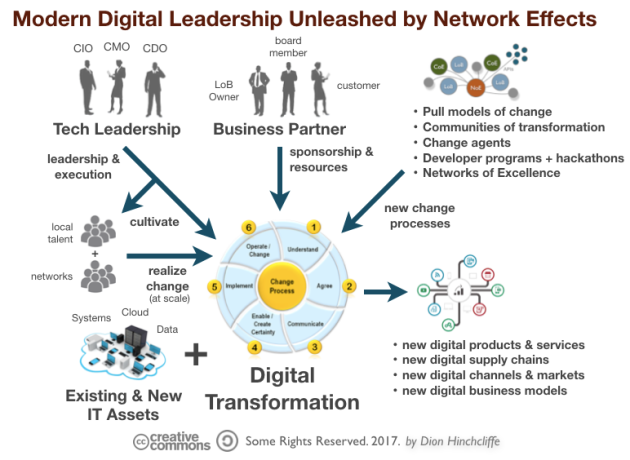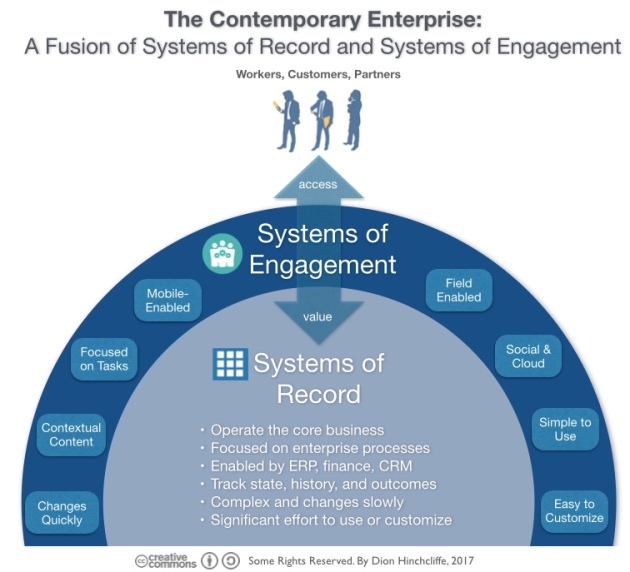Digital Transformation and the Leadership Quandary
July 17, 2017 5 Comments
The data now shows that a near majority of organizations today are undergoing digital transformation in some shape or form. By digital transformation I don’t mean IT automation of the business of course, but wholesale rethinking of some or all of the business in digital terms. It’s the greatest game in the business world right now, and necessary for long term survival, but such digital reinvention is also one of the hardest journeys to make.
Moreover, just like startups have a high failure rate (8 out of 10 don’t make it typically) in trying to do something new that’s relatively unproven, digital transformation is a endeavor fraught with high hurdles for success in any organization.
Enterprises, however, do have vast assets they can assemble on deck to ensure a successful outcome — everything from existing customer bases and supply chains to current market share and the ability to fund loss leadership to success. This drives the failure rate down much lower than typical greenfield technology startups. But as commentators such as Christian Frei estimate that two-thirds of companies still won’t make the journey successfully, and others have put the failure rate much higher.
Better and New Types of Leadership = Effective Digital Transformation
As Christian also notes, leadership is ultimately the root cause, for both success and failure in re-imagining organizations digitally:
After all these discussions, workshops, and coaching sessions, one point came out very clearly as the biggest threat companies have in this transformation.
It is not technology.
It is not their people.
It is not their business model and products.
The biggest threat and reason why most companies will fail to adjust and most likely either end up bankrupt, acquired, or marginalized…
… is their leadership mindset, which is embedded in their company culture.
The diagnoses of the reasons for implicating leadership is many and varied but essentially boils down to the reality that leadership has the most resources and control in hand, but is often lacking in digital vision and/or competency to wield these. The reality is that most leaders of large organizations today have limited experience in successfully leading either large digital efforts or enterprise-wide change efforts, and much more rarely both at the same time. While it’s likely we’ll see far more seasoned executives in this space in the next 5-10 years, that will be much too late for most organizations.
what then can leaders do now to ensure they’re doing their very best tap into and truly marshaling the deep experience, fresh thinking, and effective action they need from across their organization and indeed, from across the industry? To help address leadership in digital native terms, I’ve been promoting the concept of network leadership for some years now (and I’m not alone), realizing that all leaders must much more effectively tap into the full measure of knowledge and innovation in new channels they need to deliver on what has become the most important and challenging transitions in the history of business.
Leading (and Acting) With and Through Your Networks
Leaders have always had to work through others — their workers, business partners, and their industries — to accomplish what enterprises do. But we now have new ways and methods of doing so that are far higher scale, have more leverage, and are earned, rather than owned. Leading through the network is the only way to tap into broad enough talent, diverse ideas, and local action to accomplish the large scale changes that must be achieved today. I’ve written much about the new CIO mindset emerging and the need to better design our organizations for loss of control needed to keep up with the pace of tech change, and that these must be baked most deeply into the leadership thinking (both on high and at the root) of our organizations.
Underscoring this, I recently receive a note from a friend (who was also previously one of the top CIOs in the world in my opinion) that made me reflect that while we can (and must) let much of the network do the work for us — if we only know enough to harness it — that leadership remains critical in ensuring the ultimate outcome:
The leadership part (for what I had) was always my “secret” weapon.” Key parts of that leadership is:
– Human (recruit, develop, manage, balance)
– Technical (new and old tech, ops etc.)
– Business (core business (new and incumbent), finance and accounting)
From this we can see that people are the key to driving actual change. Technology and business, combined, are the vehicles, but not the agents of change. Leaders must cultivate, build, and tap into the best networks of people, tap into their knowledge, and empower them to create change at scale. (See the growing and vital change agents industry conversation for more thinking on this.)
Thus the essential leadership quandary with digital transformation is that leaders — formal and grassroots — simply don’t know what they don’t know yet. And many — and likely most — are simply not taking sufficient steps to learn more and faster or unleash those that know a given answer and can act.
My good friend and CIO advisor Tim Crawford put this another way today. Leaders in digital — both on the technology and business side (though the distinction is starting to get blurry these days) — must establish their network effect. For those not yet familiar with this key digital concept, it means establishing sustainable value through connection. For the CIO and other types of leaders, this means building relationship capital in all its forms (personal, organizational, industry, and digital), and then using it effectively.
Addressing the Leadership Quandary with Network Effects
As I noted in a reply to Tim, this means:
- Engaging both upwards and downwards. Establishing deep and wide social capital in the process. Done in digital channels especially, this creates an inherent network effect when combined with the the other items on this list.
- Being the conduit for change. By ensuring you empower and enable others through their relationship with you.
- Sharing knowledge. By setting it free to spread and work for you forever.
- Enabling and empowering others. Proactively, especially with change agents (which are the ones, by definition, that will effect needed change anyway).
In short, digital transformation requires a new type of leader with a digital mindset that is broadly encompassing, fueled by growing network effects, and strategically turning over non-essential control to their network of change agents to drive the many hundreds, if not thousands of local microtransformations that will collectively result in a holistic and aligned overall digital transformation. It’s a more organic, pervasive, and sustainable way and, I believe, the only real way most digital transformation will ultimately happen.
Why? Because a rich network always beats a poorly connected system in almost any situation.
Additional Reading:
How IT and the Role of the CIO is Changing in the Era of Networked Organizations
Using Online Community for Digital Transformation
How Should Organizations Actually Go About Digital Transformation?






























































